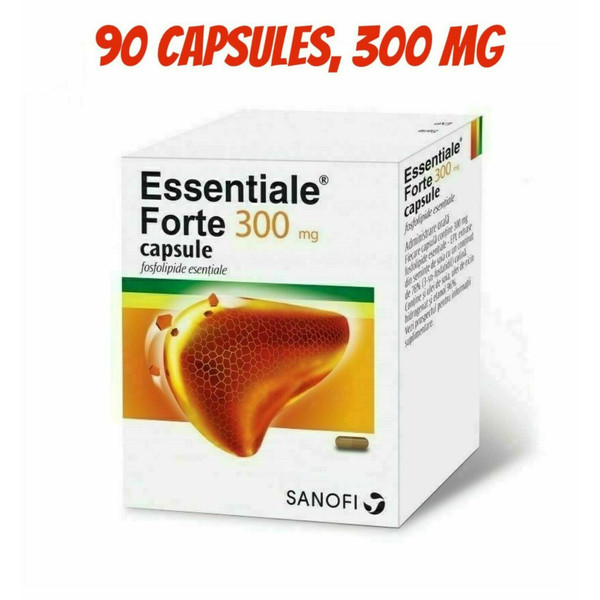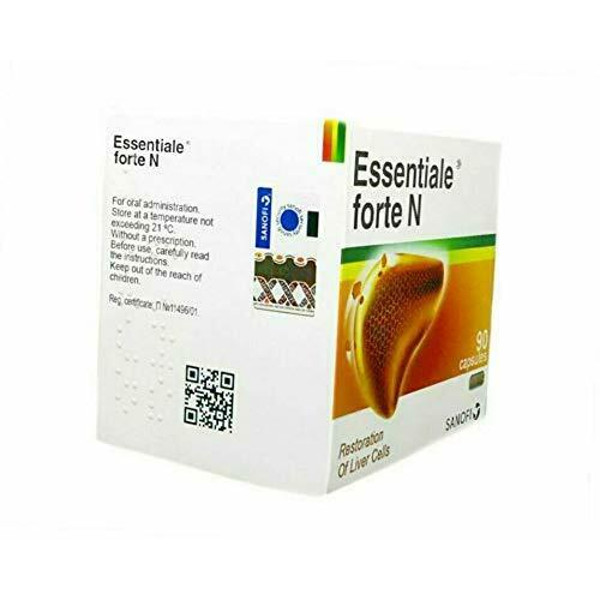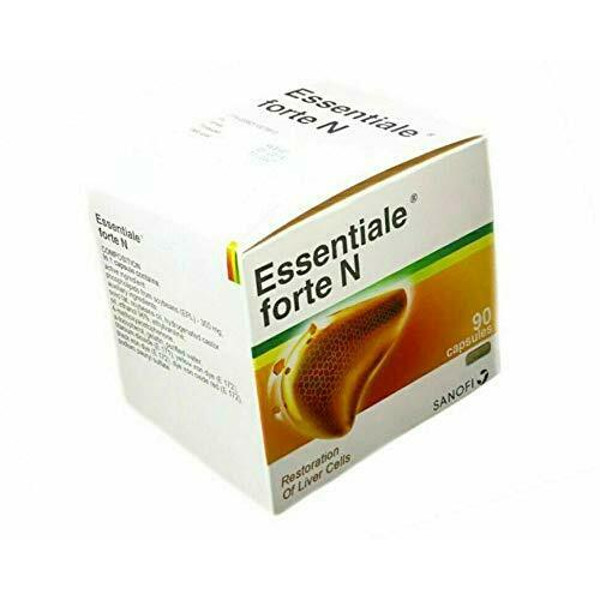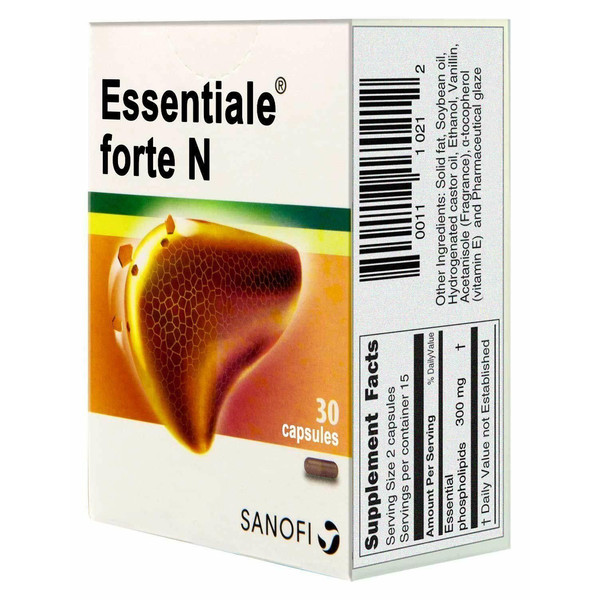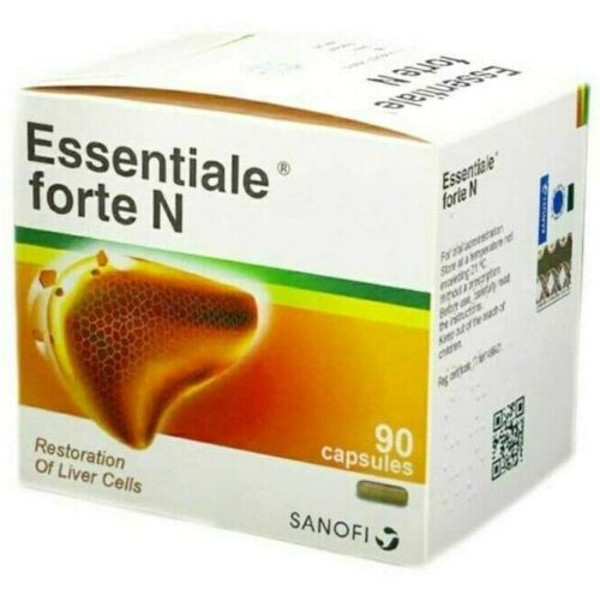ESSENTIALE FORTE N 300 mg Liver Support Protection SANOFI 90 caps
Quantity
Dosage form
No. 1 brown opaque hard gelatin capsules containing a yellowish-brown oily pasty mass.
Compound
1 capsule contains:
active ingredient: soybean phospholipids containing 76% (3-sn-phosphatidyl)-choline (synonyms: EPL, essential phospholipids) - 300 mg;
auxiliary ingredients: solid fat - 57.000 mg, soybean oil - 36.000 mg, hydrogenated castor oil - 1.600 mg, ethanol 96% - 8.100 mg, ethylvanillin - 1.500 mg, 4-methoxyacetophenone - 0.800 mg, α-tocopherol - 0.750 mg.
Capsule composition: gelatin - 67.945 mg, purified water - 11.495 mg, titanium dioxide (E 171) - 0.830 mg, iron dye yellow oxide (E 172) - 2.075 mg, iron dye black oxide (E 172) - 0.332 mg, iron dye red oxide (E 172) - 0.198 mg, sodium lauryl sulfate - 0.125 mg.
Pharmacotherapeutic group
hepatoprotective agent
Pharmacodynamics
Essential phospholipids are the main structural elements of the cell membrane and cell organelles. In liver diseases, there is always damage to the membranes of liver cells and their organelles, which leads to disruption of the activity of enzymes and receptor systems associated with them, a deterioration in the functional activity of liver cells and a decrease in the ability to regenerate.
Phospholipids, which are part of Essentiale® forte N, correspond in their chemical structure to endogenous phospholipids, but surpass endogenous phospholipids in activity due to their higher content of polyunsaturated (essential) fatty acids. The incorporation of these high-energy molecules into damaged areas of hepatocyte cell membranes restores the integrity of liver cells and promotes their regeneration. The cis-double bonds of their polyunsaturated fatty acids prevent the parallel arrangement of hydrocarbon chains in the phospholipids of cell membranes, the phospholipid structure of the cell membranes of hepatocytes is “loosened”, which leads to an increase in their fluidity and elasticity, and improves metabolism. The resulting functional blocks increase the activity of enzymes fixed on the membranes and contribute to the normal, physiological pathway of the most important metabolic processes.
Phospholipids, which are part of Essentiale® Forte, regulate the metabolism of lipoproteins, transferring neutral fats and cholesterol to the sites of oxidation, mainly by increasing the ability of high density lipoproteins to bind to cholesterol.
Thus, there is a normalizing effect on the metabolism of lipids and proteins; on the detoxification function of the liver; to restore and preserve the cellular structure of the liver and phospholipid-dependent enzyme systems; which ultimately prevents the formation of connective tissue in the liver and promotes the natural recovery of liver cells.
With the excretion of phospholipids into bile, the lithogenic index decreases and bile stabilizes.
In patients with non-alcoholic fatty liver disease, the use of essential phospholipids in controlled randomized clinical trials led to a significant reduction in the degree of steatosis.
In clinical and observational studies, against the background of the use of Essentiale® Forte N in patients with chronic liver diseases, there was an improvement in the general condition and symptoms, such as increased fatigue / weakness, decreased appetite, pain or discomfort in the abdomen, a feeling of early satiety, a feeling of fullness or heaviness after food, bloating, nausea. Significant improvement in symptoms was seen in studies as early as 4 weeks (30 days) of therapy.
The use of essential phospholipids in controlled and observational studies in patients with psoriasis led to a regression of psoriatic rashes, a decrease in the psoriasis prevalence and severity index (PASI). The addition of essential phospholipids to PUVA therapy made it possible to achieve faster remission while reducing the total dose of ultraviolet radiation.
Pharmacokinetics
More than 90% of ingested phospholipids are absorbed in the small intestine. Most of them are cleaved by phospholipase A to 1-acyl-lysophosphatidylcholine, 50% of which immediately undergoes reverse acetylation into polyunsaturated phosphatidylcholine during the process of absorption in the intestinal mucosa. This polyunsaturated phosphatidylcholine enters the bloodstream with the lymph flow and from there, mainly in the form associated with high-density lipoproteins, enters the liver.
Pharmacokinetic studies in humans have been performed with radioactively labeled dilinoleyl phosphatidylcholine (3H and 14C). The choline moiety was labeled with 3H and the linoleic acid moiety was labeled with 14C.
The maximum concentration of 3H is reached 6-24 hours after administration and is 19.9% of the prescribed dose. The half-life o
